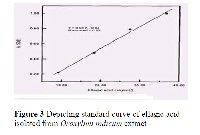Evaluation of Antioxidant and Antihyperlipidemic Activity of extracts Rich in Polyphenols
Keywords:
Polyphenols, Antihyperlipidemic, Antioxidant, Oroxylum indicum, Vitis vinifera, PolicosanolAbstract
Polyphenols are phytochemicals present in plants that contribute to their antioxidant and different pharmacological activities. Flavonoids comprise of one class of polyphenols which play a beneficial role in preventing free radical damage and owe its antioxidant property. Lipid peroxidation and lipid-derived oxidized products have been implicated in the pathogenesis of a variety of human diseases. To clarify the role of oxidative stress in prevention of atherosclerosis and hypercholesterolemia, the antioxidant status of plant extracts of Oroxylum indicum, Vitis vinifera and Policosanol isolated from, Saccharum officinarum were selected for the study. The extracts were evaluated by in vitro methods by monitoring the production of malondialdehyde as Thiobarbituric acid Reacting Substances (TBARs). The antihypperlipidemic activity was examined in cholesterol induced hyperlipidemic model using Albino Wistar rats. The result of the study exhibited significant reduction in total cholesterol, triglycerides, LDL-C, VLDL-C levels and remarkable increase in the level of HDL-C when compared to standard lovastatin drug. The artherogenic index and LDL-C: HDL-C risk ratio was also reduced to significant extent in the group treated with extracts. The levels of SGOT and SGPT were estimated and found to be significantly less than that of hyperlipidemic control group. The highest antihyperlipidemic activity was exhibited by total extract of the bark of Oroxylum indicum followed by extracts of fruits of Vitis vinifera and Policosanol isolated from sugarcane wax.
References
Renaud S, De Lorgeril. M Lancet (1993)
: 1523-1526.
Hoffman R, Garewal H Arch. Inter. Med
(1995) 155: 241-246.
Hmamouchi M etal Fitoterapia (1996) 68:
-114.
Gu, Q, Luo, H., Zheng, W., Liu, Z., and
Huang, Y Int. J. Syst. Evol. Microbiol.
(2006) 56:2193-2197.
Marinangeli CP, Kassis AN, Jain D, Ebine
N, Cunnane SC, Jones PJ N Br. J. Nutr.
(2007) 97 381–8.
Granja A, Hernandez J etal, 1997, U. S
Patent No - 5663156 Mixtures of higher
primary aliphatic alcohols, its obstention
from sugarcane wax and its pharmaceutical
uses.
Edwards RL, Lyon T, Litwin SE, Rabovsky
A, Symons JD, Jalili T J. Nutr. (2007) 137:
–11.
Ohikawa H, Oshini N, Yagi K Anal. Bio.
chem. (1979) 95: 351-358.
Devasagayam TPA, Boloor KK,
Ramasarma T Indian J Biochem Biophy,
(2003) 40: 300 -303.
Lamaison J, Ptitjean- Freylet Pharm. Acta.
Helvetia, (1991) 66: 185-188.
Dhuley J, Naik SR, Rele S, Benarji A
Pharm. Pharmacol. commun. (1999) 5
:689-670.
Wiliamson E, Okpako M, Evans FJ,
Pharmacological methods in phytotherapy
research, (1st edn) Wiley and sons
publication USA. 1996.
P. Iacopini, M. Baldi,, Storchi, L. Sebastiani
Catechin, epicatechin, quercetin, rutin and
resveratrol in red grape: Content, in vitro
antioxidant activity and interactions.
Journal of Food Composition and Analysis
(2008) 21 589– 598
Roy MK, Nakahara K, Na TV,
Trakoontivakorn G, Takenaka M, Isobe S,
Tsushida T. Baicalein, a flavonoid extracted
from a methanolic extract of Oroxylum
indicum inhibits proliferation of a cancer
cell line in vitro via induction of apoptosis.
Pharmazie (2007) 62, 149-53.
Dahlen, G.H. Lp (a) lipoprotein in
cardiovascular disease. (Review article and
viewpoint).Atherosclerosis (1994) 108 111-
Edwards, C., Bouchier, I., Haslett, C. and
Chilvers, E. Ischamic (Coronary) Heart
Disease. In: Davidsons Principles and
Practice of Medicine (1999). 18th ed.
pp.245-266.
Farmer, I.A. and Gotto, A.M. Dyslipidemia
and other risk factors for coronary artery
disease. In: Heart Disease. A textbook of
cardiovascular medicine. Braunwald (1997)
th edition, pp.1126-1160.
Gensini, G.F., Comeglio, M. and Colella,
A. Classical risk factors and emerging
elements in the risk profile for coronary
artery disease. Euro. Heart J. (1998)
(Supp. A): A53-A61.
Ochani PC, D’Mello P Indian J of
experimental biology (2009). 47: 276-282.
Ardlie N, Selley M, Simons L
Arterosclerosis (1989) 76: 117-124.
Bagchi K, Puri S Eastern Mediterranean
Health Journal (1998) 4: 350-360.
Augusti KT,Narayan A, Pillai LS Indian J
of experimental biology, (2001) 39: 660-
Peter PT. The "Good Cholesterol" -HighDensity Lipoprotein, Cardiology Patient
Page, American Heart Association, Inc.



